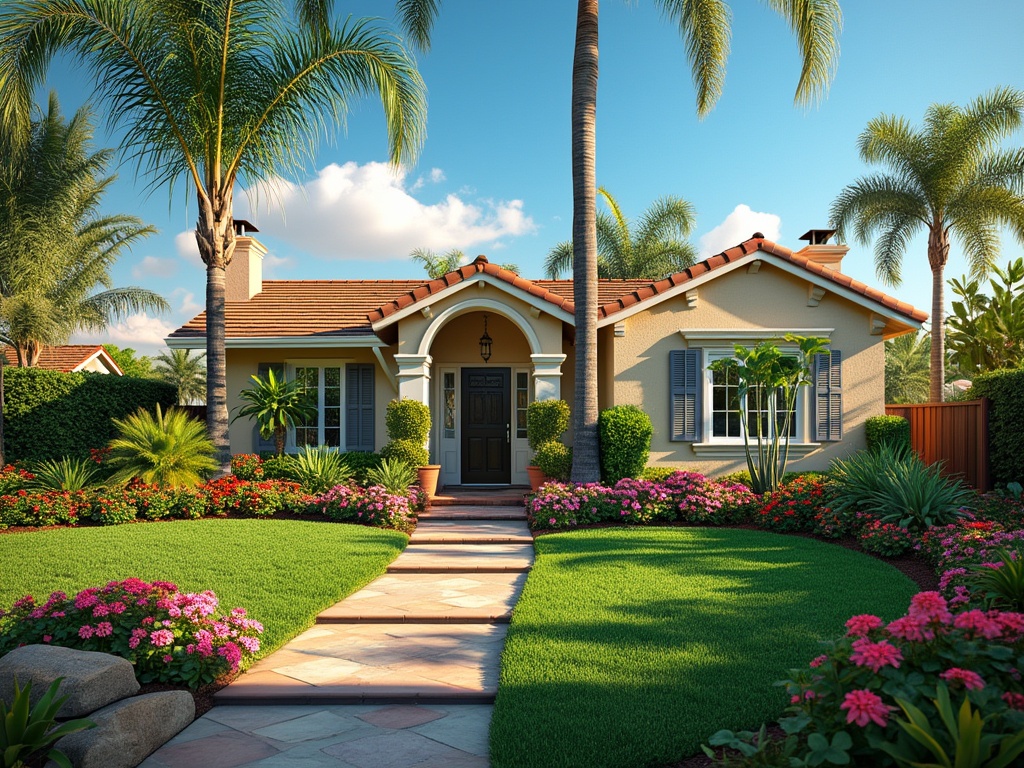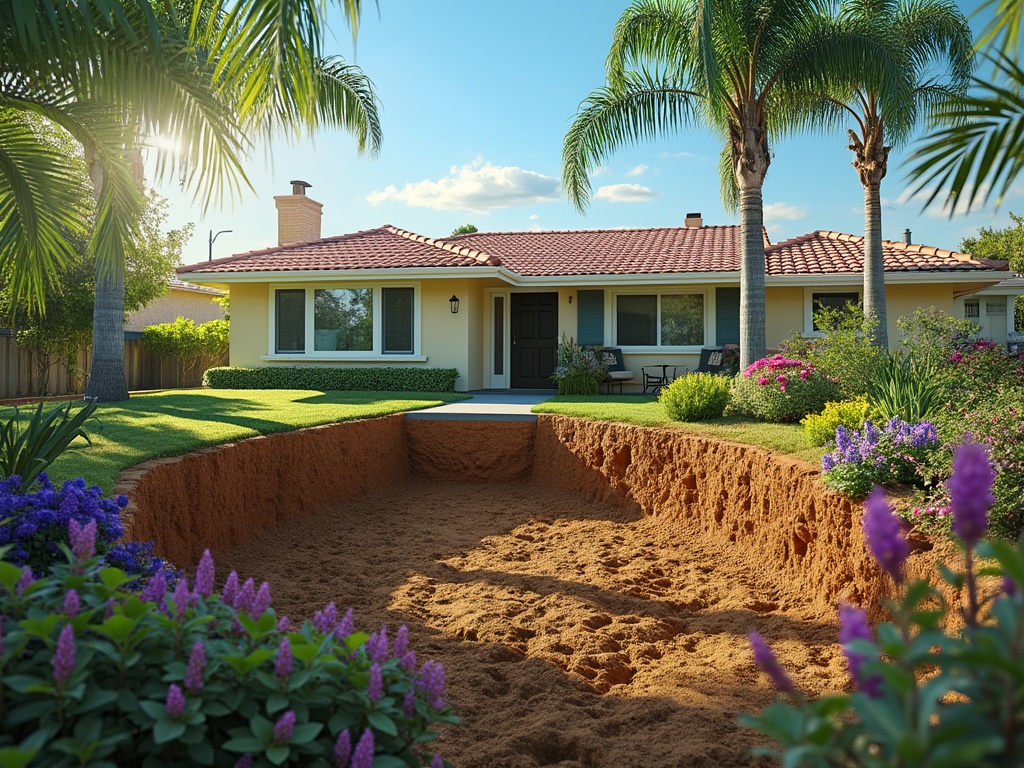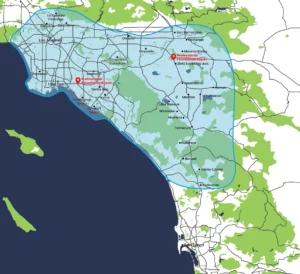Clay soil can wreak havoc on your home’s foundation in La Habra. This type of earth expands when wet and shrinks when dry, causing cracks and shifts. Our blog post will show you how to tackle these tricky soil issues head-on.
Learn about soil stabilization methods that can save your home’s base.
Key Takeaways
- Clay soil in La Habra expands when wet and shrinks when dry, causing foundation damage.
- Soil stabilization techniques like mechanical and chemical methods prevent foundation shifts and cracks.
- Polyjacking uses expanding foam to lift and level concrete slabs quickly and cost-effectively.
- Soil injection pumps special mixtures into the ground to strengthen weak soil without extensive excavation.
- La Habra’s average annual rainfall of 14.67 inches contributes to soil changes that can harm home foundations.

Why Soil Stabilization is Essential for Foundation Repair
Soil stabilization plays a crucial role in foundation repair, especially in La Habra’s clay-rich terrain. Clay soil expands when wet and shrinks during dry spells, causing foundations to shift and crack.
With La Habra’s average annual rainfall of 14.67 inches, these soil changes can wreak havoc on homes. Stabilizing the soil helps prevent this movement, protecting foundations from damage.
Proper soil stabilization techniques improve the soil’s strength and reduce its tendency to expand or contract. This process creates a stable base for your home, preventing common issues like wall cracks and uneven floors.
By addressing the root cause of foundation problems, soil stabilization offers a long-lasting solution for homeowners in Southern California. It’s an essential step in maintaining your property’s value and structural integrity.
Effective Soil Stabilization Techniques
Soil stabilization techniques offer powerful solutions for clay soil issues. These methods improve soil strength and reduce movement, protecting your home’s foundation.
Mechanical Stabilization Methods
Mechanical stabilization methods offer effective solutions for clay soil challenges in La Habra. These techniques improve soil structure and boost land resilience, making them ideal for homeowners facing foundation issues.
- Soil Compaction: This method increases soil density by applying pressure. It reduces water content and air voids, creating a more stable base for structures.
- Geotextile Reinforcement: Synthetic fabrics are laid between soil layers. They add strength, separate materials, and improve drainage in clay soils.
- Aggregate Addition: Mixing gravel or crushed stone with clay soil enhances its properties. This blend increases permeability and reduces soil movement during wet and dry cycles.
- Deep Dynamic Compaction: Heavy weights are dropped repeatedly on the ground surface. This technique densifies loose soils at greater depths, ideal for areas with deep clay deposits.
- Vibroflotation: A vibrating probe is inserted into the ground to compact granular soils. It’s useful for improving soil bearing capacity in areas with mixed clay and sand.
- Stone Columns: Vertical columns of compacted stone are installed in weak soils. They provide drainage paths and increase the overall strength of the soil mass.
- Soil Nailing: Steel rods are driven into slopes or excavation walls. This method stabilizes soil masses and prevents movement in challenging terrain.
- Mechanically Stabilized Earth Walls: These structures use reinforcing elements within compacted soil. They create stable retaining walls for areas with expansive clay soils.
Chemical Stabilization Methods
Chemical stabilization methods offer effective solutions for clay soil challenges in La Habra. These techniques improve soil properties, ensuring a stable foundation for homes. Here are key chemical stabilization methods:
- Cement mixing: This process blends cement with soil to reduce moisture content. It allows better compaction, creating a solid base for foundations.
- Quicklime application: Contractors use quicklime to dry and strengthen clay soil rapidly. This method works within hours, making it ideal for time-sensitive projects.
- Lime Kiln Dust (LKD) treatment: LKD stabilizes soil for parking lots and building pads. It’s a cost-effective option for larger areas needing soil improvement.
- Fly Ash incorporation: Class C fly ash is self-cementing, while Class F requires lime addition. Both types enhance soil stability, supporting structures in extreme weather.
- Biochemical stabilizers: These agents alter soil properties at a molecular level. They create a more reliable foundation, crucial during droughts or heavy rains.
- Electrochemical treatments: This method uses electrical currents to change soil structure. It’s particularly useful for improving crawl space conditions.
- Inorganic pozzolanic binders: These materials react with soil to form strong bonds. They increase the soil’s load-bearing capacity, vital for supporting heavy structures.
- Organic polymeric stabilizers: These compounds create a water-resistant barrier in the soil. They help maintain soil integrity during wet seasons, protecting the foundation.
Polyjacking
Polyjacking offers a smart fix for uneven concrete in La Habra homes. This method uses high-density foam to lift and level concrete slabs. The foam expands and hardens, giving strong support to the concrete.
Homeowners benefit from its quick results and lower costs compared to replacing entire slabs.
Safety matters in foundation repair. Polyjacking uses non-toxic materials, making it eco-friendly. Before starting, experts carefully check the site to ensure the best outcome. This careful planning helps create a reliable solution for La Habra’s clay soil challenges.

The Role of Soil Injection in Stabilizing Clay Soils
Soil injection offers a powerful solution for stabilizing clay soils in La Habra. This method pumps special mixtures deep into the ground to strengthen weak soil. Read on to learn how this technique can protect your home’s foundation.
Benefits of Soil Injection
Soil injection offers homeowners in La Habra a powerful solution for clay soil challenges. This method boosts soil stability and protects foundations from damage.
Benefits of soil injection include:
- Increased soil integrity: The process strengthens clay soil, reducing its tendency to expand and contract. This stability helps prevent foundation shifts and cracks.
- Non-invasive repair: Unlike other methods, soil injection doesn’t require extensive excavation. This means less disruption to your property and landscaping.
- Cost-effective solution: Soil injection often costs less than traditional foundation repair methods. It addresses the root cause of the problem, potentially saving money in the long run.
- Enhanced soil quality: The injected materials improve the soil’s structure and load-bearing capacity. This creates a more stable base for your home’s foundation.
- Weather resistance: Treated soil better withstands extreme weather conditions. This added protection helps guard against future foundation issues.
- Long-lasting results: Many soil injection services come with a lifetime limited warranty. This offers peace of mind for homeowners concerned about ongoing foundation problems.
- Improved load capacity: The treatment increases the soil’s ability to support weight. This added strength helps combat damage from settling and shifting.
- Versatile application: Soil injection works well for various foundation types, including concrete slabs and pier and beam structures. This makes it a flexible option for many homes.
How Soil Injection Works
Soil injection is a cutting-edge method for stabilizing clay soils in La Habra. This process uses a special two-part polyurethane compound to strengthen the ground beneath foundations.
- Site evaluation: Experts assess the soil conditions and identify problem areas.
- Injection point selection: Strategic spots are chosen for maximum effect.
- Compound injection: The polyurethane mix is pumped into the soil through small holes.
- Expansion and filling: The compound spreads out, filling voids and binding loose soil particles.
- Solidification: The mixture hardens quickly, creating a stable base for structures.
- Slope stabilization: Injected material helps prevent erosion on hillsides.
- Environmental safety: The compound is inert and won’t harm the surrounding ecosystem.
- Fast-acting solution: Results are often visible within hours of application.
- Minimal disruption: Unlike traditional methods, soil injection requires little excavation.
- Long-lasting effects: The stabilized soil maintains its strength for years, boosting reliability.
Conclusion: Ensuring Foundation Integrity in La Habra
Clay soil challenges in La Habra demand expert solutions. Professional foundation repair services offer vital stabilization techniques. These methods protect homes from costly damage.
Homeowners can trust skilled technicians to apply the right fixes. With proper care, La Habra foundations will stand strong for years to come.
FAQs
1. How does clay soil affect foundations in La Habra?
Clay soil expands when wet and shrinks when dry. This constant movement can damage foundations. In La Habra, clay soil challenges often require specialized repair methods, such as pile installation, to stabilize structures.
2. What are the signs of foundation problems caused by clay soil?
Look for cracks in walls, uneven floors, or doors that stick. These issues may signal foundation damage from clay soil. La Habra homes built on clay often need expert assessment to identify and fix these problems.
3. Can pile installation solve clay soil foundation issues in La Habra?
Yes, pile installation is an effective solution for clay soil challenges. Piles transfer the weight of the structure to stable soil layers beneath the clay. This method helps prevent future foundation movement in La Habra homes.
4. How long does foundation repair using piles typically take?
The duration of pile-based foundation repair varies. Factors include the size of the structure and soil conditions. Most La Habra projects take a few days to a week. A professional assessment will provide a more accurate timeline for your specific situation.



